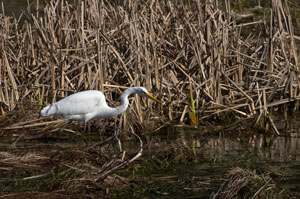Great Egret or Great White Heron
Ardea alba

|

|
| Click any photo with bllue border to expand |

|
| photo by Martha Van Natta |

|
| photo by Martha Van Natta |
The name 'egret' comes from the French word 'aigrette' which means 'ornamental tufts of plume.' During breeding season, you can see the plumes near the tail. As you can well imagine, the egret was hunted to near extinction in the 1800s and early 1900s for its beautiful white plummage. It is now protected in North America. The egret can be seen all over the United States, Mexico, Central America, and the southernmost areas of Canada. This bird migrates except in parts of western Oregon where it lives year around.
The Great Egret is frequently seen fishing in close proximity to the Great Blue Heron. You can see the egret hunting for fish, aquatic insects, frogs, and crayfish in marshes, canals, bays, and other wetlands. The egret walks slowly through the shallow water, its attention focused on its prey, and then darting its bill quickly to make its catch. If you are close enough, you may see its neck undulating as it slowly walks through the water. This bird is not shy, and you can get fairly close to it for picture taking or observation.
The Great Egret raises one brood per year. The male and female build a platform nest in colonies with other egrets, herons, ibis, and other similar species, in a tree or shrub10-40 feet high, usually above the ground. The male, the female and the juvenile all look alike. The Great Egret raises one brood per year, laying from 2-6 pale blue-green or light blue eggs and incubating them for 23-26 days by the male and the female. The young are fed by both parents and stay in the nest from 43-49 days.
by Martha Van Natta
Additional information: see Wikpedia - Great_egret